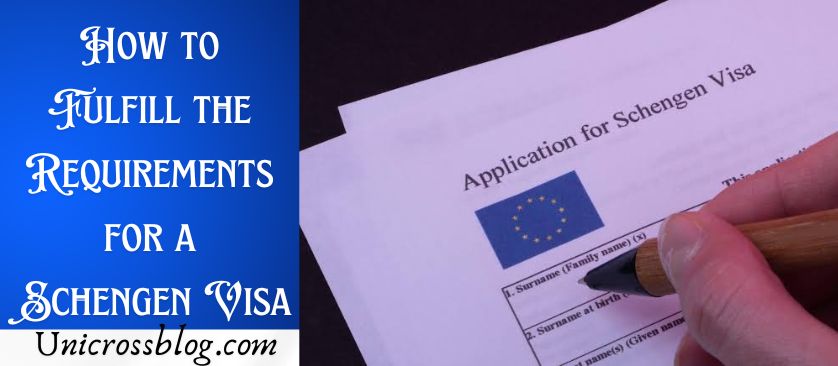A Schengen Visa allows travelers to move freely across 27 European countries that are part of the Schengen Area. Whether you’re visiting for business, tourism, or family reasons, it’s essential to understand the visa requirements and ensure that you submit the proper documentation. In this guide, we’ll walk you through the steps of fulfilling the requirements for a Schengen Visa.

What is a Schengen Visa?
A Schengen Visa is a short-stay visa that grants the holder the ability to travel to any of the countries within the Schengen Area for a period of up to 90 days within a 180-day period. These countries have abolished border controls between them, making travel easier. Some of the most well-known Schengen countries include France, Germany, Italy, Spain, and the Netherlands.
Step-by-Step Guide to Fulfilling the Requirements for a Schengen Visa
1. Determine the Type of Schengen Visa You Need
Before applying for a Schengen Visa, it’s important to determine which type of visa you need. The most common types include:
- Tourist Visa (Type C): For short trips, leisure, or tourism.
- Business Visa (Type C): For business-related trips, including meetings, conferences, or negotiations.
- Family Visit Visa (Type C): For visiting family members living in Schengen countries.
- Airport Transit Visa (Type A): For travelers passing through Schengen airports without leaving the international transit area.
You need to apply for the visa that matches your purpose of travel.
2. Determine the Country You Are Applying To
While Schengen countries have no internal borders, you must apply for the visa through the country that is your main destination or the country where you will spend the most time. If you’re visiting multiple Schengen countries and none is your primary destination, apply to the country you will enter first.
3. Check the Schengen Visa Requirements
The requirements for a Schengen Visa may vary slightly depending on the country you are applying to, but generally, the following documents are required:
- Visa Application Form: Completed and signed.
- Passport: Valid for at least three months beyond your planned departure date from the Schengen Area, with at least two blank pages.
- Passport-sized Photos: Recent and in line with Schengen visa photo requirements.
- Travel Itinerary: Details of your planned travel dates and itinerary, including hotel bookings and flight reservations.
- Travel Insurance: Proof of travel medical insurance that covers emergencies with a minimum coverage of €30,000 for the duration of your stay in the Schengen Area.
- Proof of Financial Means: Bank statements, pay slips, or proof of sufficient funds to support your stay in the Schengen Area.
- Cover Letter: A letter explaining the purpose of your trip and your itinerary.
- Visa Fee: Payment of the required visa fee, which generally ranges from €60-€80.
- Accommodation Proof: Hotel booking or an invitation letter from a host if you’re staying with someone.
- Travel History (if applicable): Any previous visas or travel records to the Schengen Area or other international destinations.
- Employment or Education Status: A letter from your employer or educational institution confirming your leave or attendance.
4. Book an Appointment at the Consulate or Visa Center
Once you have all the required documents, schedule an appointment at the embassy or consulate of the country you’re applying to. Some countries may also use third-party visa application centers, such as VFS Global or TLScontact, where you can submit your application.
5. Submit Your Documents
At the appointment, submit your completed application form along with all the required documents. Depending on the country, you may be asked to attend an interview, during which you may be asked to explain your travel plans.
6. Wait for Processing
Processing times for Schengen Visas vary but generally take 15 calendar days from the date of your application. In some cases, it could take longer if additional documents are required or if the application is more complex.
7. Collect Your Visa
Once your visa is approved, you will be notified, and you can collect your passport with the visa stamped in it. You can then begin preparing for your trip to the Schengen Area.
Tips for a Successful Schengen Visa Application
- Apply Early: Apply for your visa at least 3 to 4 weeks before your planned travel date, as processing can take time.
- Double-check Your Documents: Ensure that all required documents are submitted and correctly filled out. Incomplete applications will likely be rejected.
- Travel Insurance: Ensure your insurance meets the Schengen requirements. It must cover medical expenses, emergency evacuation, and repatriation.
- Proof of Funds: Provide solid proof that you have enough funds to cover your stay, such as recent bank statements or pay slips.
- Travel Itinerary: Have a detailed itinerary with confirmed hotel reservations, flight bookings, and transport details.
READ ALSO: 10 Common Mistakes in Tourist Visa Applications
FAQs
How long does it take to process a Schengen Visa?
Processing time typically takes 15 calendar days. However, this can vary based on the consulate or embassy, your nationality, or the complexity of your application.
How long can I stay in the Schengen Area with a Schengen Visa?
With a Schengen Visa, you can stay in the Schengen Area for up to 90 days within a 180-day period. This is for short stays only.
Can I travel to multiple Schengen countries with a Schengen Visa?
Yes, you can travel to multiple Schengen countries with a valid Schengen Visa, as long as your travels fall within the allowed 90 days in a 180-day period.
Do I need a Schengen Visa if I am a citizen of a Schengen country?
No, if you are a citizen of a Schengen country, you do not need a visa to travel within the Schengen Area.
What if I am traveling for business?
If you are traveling for business purposes, you will need to apply for a Business Visa, which has specific requirements like an invitation letter from the company you will be visiting.
Can I work in the Schengen Area with a Schengen Visa?
No, a Schengen Visa does not allow you to work in the Schengen Area. It is for short stays only, such as tourism, business trips, or family visits. If you want to work, you’ll need to apply for a work visa.
What happens if my Schengen Visa is denied?
If your visa application is denied, you will receive a letter explaining the reason for the rejection. You can appeal the decision or submit a new application with additional documents to address the issues.
Conclusion
Applying for a Schengen Visa requires attention to detail and the preparation of several documents. Understanding the specific visa requirements for your situation is crucial for a smooth application process. By following the step-by-step guide above and ensuring that all documentation is complete and accurate, you will increase your chances of obtaining a Schengen Visa and enjoying your trip to Europe.







